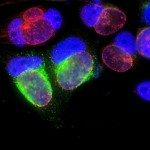Lien vers Pubmed [PMID] – 34809429
Lien DOI – 10.1021/acssynbio.1c00395
ACS Synth Biol 2021 Dec; 10(12): 3445-3460
Here, we enhanced the popular yeast display method by multiple rounds of DNA and protein engineering. We introduced surface exposure-tailored reporters, eUnaG2 and DnbALFA, creating a new platform of C and N terminal fusion vectors. The optimization of eUnaG2 resulted in five times brighter fluorescence and 10 °C increased thermostability than UnaG. The optimized DnbALFA has 10-fold the level of expression of the starting protein. Following this, different plasmids were developed to create a complex platform allowing a broad range of protein expression organizations and labeling strategies. Our platform showed up to five times better separation between nonexpressing and expressing cells compared with traditional pCTcon2 and c-myc labeling, allowing for fewer rounds of selection and achieving higher binding affinities. Testing 16 different proteins, the enhanced system showed consistently stronger expression signals over c-myc labeling. In addition to gains in simplicity, speed, and cost-effectiveness, new applications were introduced to monitor protein surface exposure and protein retention in the secretion pathway that enabled successful protein engineering of hard-to-express proteins. As an example, we show how we optimized the WD40 domain of the ATG16L1 protein for yeast surface and soluble bacterial expression, starting from a nonexpressing protein. As a second example, we show how using the here-presented enhanced yeast display method we rapidly selected high-affinity binders toward two protein targets, demonstrating the simplicity of generating new protein-protein interactions. While the methodological changes are incremental, it results in a qualitative enhancement in the applicability of yeast display for many applications.

